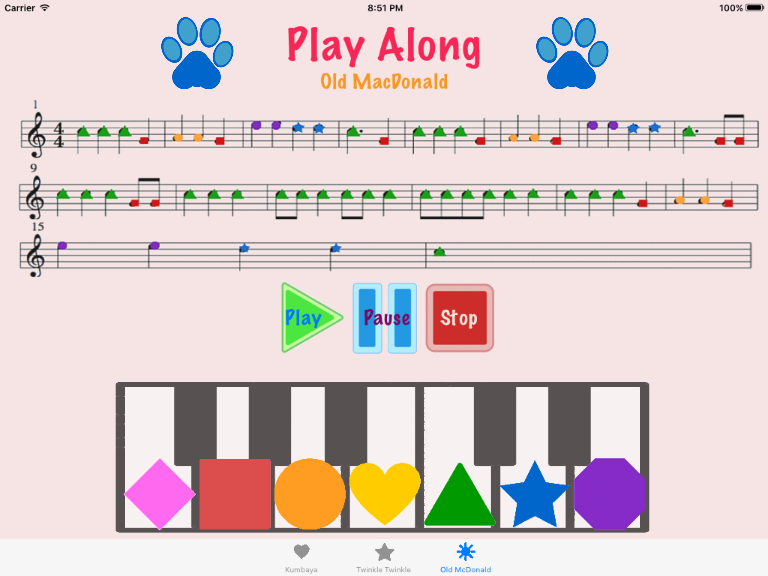
Students learned how to create music-related applications on iPads and iPhones in the Digital Arts Initiative class Music 398 “iOS Programming in Music,” taught by Associate Professor of Music Education Brian Moore this spring.
“This is the fourth time I’ve taught it,” Moore said. “It’s part of a National Science Foundation project to combine computational and creative thinking in similar courses. This was an attempt to do a music-based coding course.”
The Apple mobile operating system works well for that.
“One of the ideas is to ask students to work in the logical part of their brain, thinking-wise, but also then the creative part,” he said. “The iOS development is a great platform to do that because it’s so visually engaging.”
The course assumes students come in with no computer programming background or ability.
“The premise of it is you are learning how to write apps for either the iPhone or the iPad, and all of the apps have some kind of musical component to it,” Moore said. “So I also make the requirement that anything they design, from a graphic design standpoint, they have to create themselves, so they can’t go to the internet and grab material off of there. And all of the music that they use in their apps, they have to compose.”
Some of the assignments included creating five sounds that students could turn into an instrument; writing 30 seconds of original music that could be used either as the main piece in an app or background music; on the design side, they had to create a fake app and the buttons or widgets that could be used in an app; a “Hello, World!” app to learn basic programming; an About Me app; as well as a series of Lab apps to help learn certain concepts and processes.
“They had to write an app that would simply play a given audio file, and then they had to write another app that could play two audio files at the same time, as well as one that would display web content or a pdf document,” he said.
Finally, they had two larger projects. The first assignment was to create an app that would turn their device into a musical instrument.
“We had a very wide range of ideas. In the same way there are text fonts, there are actually sound fonts out there, so one student wrote an app to create an air horn. Somebody else wrote one that was a cat scale. They had pictures of cats, and as you touch the cat, you heard a different note on the scale. Part of it was just having fun and being able to do creative work,” Moore said.
The final project involved either extending their musical instrument project, or creating another app from scratch.
“I’d say half the class was music majors, and the other half weren’t, but they were all music technology minors,” Moore said. “So it was really interesting to see what the different apps were.”
One student created a violin app to teach kids how to finger the violin. The student who created the air horn added wind chimes and a thumb drone for their final app.
“One music education student wrote an app for little kids called ‘Play Along,’” Moore said. “This is a working keyboard, so you can tap the notes. It helps kids learn the piano notes because she put shapes on the keyboard to help them learn. She could use that in her teaching.”
Eric Hitt, a BM senior from Chippewa Falls, Wisconsin, created “Pitchtronome.”
“As a bass player, I practice with a metronome and a drone pitch for intonation,” Hitt said. “I thought it would be helpful to have an app that has pitched beeps without a constant drone, so I’m less reliant on the drone. It was very fun and challenging to work with Dr. Moore, and I’m very pleased with the end result. Now I can pull my phone out of my pocket and show people my app.”
He was glad he took the course.
“I think the class is state-of-the art,” he said. “Before I knew very little about programming, but I always thought Apple technology was cool. Now I know how to build apps for my own phone.”
Moore said when he talks to students afterwards, they tell him it was hard at first, but once they get the hang of it, it makes sense.
“I think some of them really have a knack for it,” he said. “So how do we push this forward, along with the whole creative coding. We’re going to see more of that, not less of it in the future. I’d like to keep teaching the course. I think there’s enough interest to keep it going.”
Hitt said, “I’ve gained programming knowledge, specifically how it can be useful in a music career. This class was very beneficial to me because I now have skills to design apps and compete in the 21st century music industry.”
Moore hopes students also learn how to solve problems more easily.
“I hope they can take problems and break them down and to think logically,” he said. “Also that problem solving where ‘Okay, something is wrong, if I do this and it works, then it can’t be that. Now I go onto this.’ That thinking is not intuitive for a lot of people. Musicians, a lot of times, are good at that. If they’re practicing something, and it’s not going well, they can figure out how to break that down and do things to it.”
He also thinks it’s a good creative outlet.
“I hope it’s another venue for being creative,” he said. “We need more people that can do that sort of thing.”